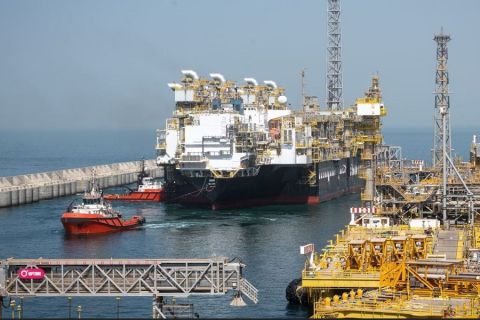The OPEC+ deal to boost crude oil output from August was always the most likely outcome to the producer group’s earlier impasse, and it should be enough to end market talk of $100 oil, at least for now.
OPEC+ ministers agreed on July 18 to boost production by 400,000 bbl/d from August to December, adding a total of 2 million bbl/d to global supply by the end of the year.
Additionally the group, which includes OPEC and allies such as Russia, agreed to new production allocations from May 2022, resolving the dispute sparked by the United Arab Emirates (UAE), which had wanted the baseline for its output quota raised.
The UAE will see its baseline gain by about 332,000 bbl/d from May, while Saudi Arabia and Russia will enjoy increases of 500,000 bbl/d each, with Iraq and Kuwait getting jumps of 150,000 bbl/d each.
OPEC+ also plans to end all output restrictions by September 2022, but this will depend on the state of the global oil market around that time.
With the impasse resolved, and more crude returning to global supply, the question for the market is now simple, but difficult to answer.
Will the increase in supply overwhelm the recovery in demand, leading to a lower crude price?
The bullish narrative remains that the world economy is recovering from the coronavirus pandemic, with more countries opening back up as populations receive vaccines against COVID-19, the disease caused by the coronavirus.
The bearish narrative is that this process may be happening, but it isn't happening fast enough and is unevenly spread, with North America and Europe recovering faster and Asia and the developing nations of Africa and South America lagging.
RELATED:
What’s Affecting Oil Prices This Week? (July 19, 2021)
So far the evidence from crude oil demand appears to favor the bearish narrative, especially in the top oil-importing region of Asia.
Asia’s crude imports for July are estimated at 22.59 million bbl/d by Refinitiv Oil Research, which is down from 23.78 million bbl/d in June and 23.04 million bbl/d in May.
While this estimate may be revised higher as the end of the month approaches, it is early evidence that crude oil demand is far from an upward trajectory in Asia.
July’s weakness is largely down to falling demand in India, the region's number two importer behind China, with Refinitiv forecasting the South Asian nation will bring in 3.33 million bbl/d, down from June’s 4.14 million bbl/d.
The drop can largely be ascribed to India's renewed coronavirus outbreak in recent months, which cut fuel demand as parts of the economy were locked down in a bid to halt the spread of the disease.
But China's July imports, forecast at 9.55 million bbl/d, are also down from June's 9.81 million bbl/d, while Japan is expected to bring in 2.01 million bbl/d, down from 2.27 million bbl/d.
Among the top four importers in Asia, only South Korea, which is likely to overtake Japan as the number three oil buyer in the region, is predicted to bring in more crude in July than in June, and even then the gain is relatively small, 3.17 million in July compared with 2.76 million for the prior month.
Price Discord
There is also something of a disconnect in Asia between prices for paper crude futures, such as global benchmark Brent and physical cargoes sold out of the main exporting region of the Middle East.
One such measure is the Brent-Dubai exchange for swaps, which measures the gap between Brent futures and physical crude in Dubai.
The premium of Brent futures over Dubai swaps ended at a relatively wide $3.79/bbl on July 16, not far off the recent peak of $4.38 on July 7, which was the highest since April 2018.
In effect this means that paper Brent, and the physical crudes priced off it such as those from Angola and Nigeria, are trading at a historically high premium to cargoes from the Middle East.
With the OPEC+ deal now in place, it's likely that investors in the paper market will be forced to confront the reality that for much of the world physical crude demand remains soft, and well below pre-pandemic levels.
Brent futures lost some ground in early Asian trade on July 19, dropping as low as $72.60/bbl, down 1.3% from the close on July 16.
The OPEC+ agreement doesn’t necessarily end the bullish case for oil demand, but it does alter the supply part of the equation, and it means predictions of $100 oil in coming months, made by some investment banks and market participants, are less likely to materialize.
Recommended Reading
BP: Gimi FLNG Vessel Arrival Marks GTA Project Milestone
2024-02-15 - The BP-operated Greater Tortue Ahmeyim project on the Mauritania and Senegal maritime border is expected to produce 2.3 million tonnes per annum during it’s initial phase.
Deepwater Roundup 2024: Offshore Australasia, Surrounding Areas
2024-04-09 - Projects in Australia and Asia are progressing in part two of Hart Energy's 2024 Deepwater Roundup. Deepwater projects in Vietnam and Australia look to yield high reserves, while a project offshore Malaysia looks to will be developed by an solar panel powered FPSO.
E&P Highlights: Feb. 26, 2024
2024-02-26 - Here’s a roundup of the latest E&P headlines, including interest in some projects changing hands and new contract awards.
Deepwater Roundup 2024: Offshore Africa
2024-04-02 - Offshore Africa, new projects are progressing, with a number of high-reserve offshore developments being planned in countries not typically known for deepwater activity, such as Phase 2 of the Baleine project on the Ivory Coast.
The OGInterview: How do Woodside's Growth Projects Fit into its Portfolio?
2024-04-01 - Woodside Energy CEO Meg O'Neill discusses the company's current growth projects across the globe and the impact they will have on the company's future with Hart Energy's Pietro Pitts.





